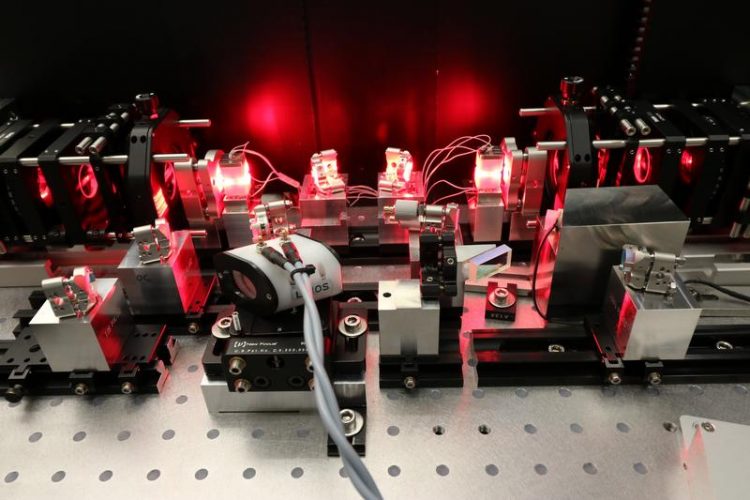Satellite-based Laser Measurement Technology against Climate Change

Picture 1: Lab demonstrator of a diode-pumped alexandrite laser for climate-relevant measuring in high-altitude atmosphere. © Fraunhofer ILT, Aachen, Germany
The fight against global climate change poses one of the greatest challenges of the coming decades. To develop effective measures against global warming, scientists need climate models that reliably represent interrelationships in the atmosphere. Currently, there is insufficient data about such relationships at high altitude (mesosphere), where crucial processes for global air circulation occur.
For the measurement of temperature and wind speed at this altitude, climate researchers rely on the modern resonance-lidar process. However, due to the complexity and the weight, these laser measuring systems are being used almost exclusively on the ground.
The work in ALISE constitutes the first step in developing a satellite-based observation system that enables wind and temperature conditions to be measured temporally and spatially in high-resolution in the mesosphere.
To accomplish this, the efficiency of the laser beam source, an alexandrite laser, needs to be increased by using laser diodes as a pump source. Furthermore, complexity and component weight will be reduced so that the requirements for space-based missions can be met.
In order to take advantage of laser measurement technology in satellite-based Earth observation, the scientists from Aachen have applied their many years of experience and expertise to developing laser beam sources and optical components for atmospheric measurements.
They were already able to demonstrate this, among others, in the Franco-German climate mission »MERLIN« and the »CHARM-F« project. The CHARM-F system recently successfully completed its first flight on the German research aircraft HALO (High Altitude and Long Range Research Aircraft) of the German Aerospace Center (DLR).
ALISE is supervised by the DLR, while the project budget is entirely provided by the Federal Ministry of Economic Affairs and Energy (FKZ: 50RP1605).
Please visit the DLR-website for additional information about the ALISE project: www.dlr-innospace.de/startseite/gefoerderte-projekte/alise/
Contact
Dr. rer. nat. Michael Strotkamp
Nonlinear Optics and Tunable Lasers Group
Phone +49 241 8906-132
michael.strotkamp@ilt.fraunhofer.de
Dipl.-Ing. Hans-Dieter Hoffmann
Head of the Competence Area Lasers and Laser Optics
Phone +49 241 8906-206
hansdieter.hoffmann@ilt.fraunhofer.de
Media Contact
All latest news from the category: Machine Engineering
Machine engineering is one of Germany’s key industries. The importance of this segment has led to the creation of new university degree programs in fields such as production and logistics, process engineering, vehicle/automotive engineering, production engineering and aerospace engineering among others.
innovations-report offers informative reports and articles covering technologies such as automation, motion, power train, energy, conveyor, plastics, lightweight construction, logistics/warehousing, measurement systems, machine tools and control engineering.
Newest articles

Pinpointing hydrogen isotopes in titanium hydride nanofilms
Although it is the smallest and lightest atom, hydrogen can have a big impact by infiltrating other materials and affecting their properties, such as superconductivity and metal-insulator-transitions. Now, researchers from…

A new way of entangling light and sound
For a wide variety of emerging quantum technologies, such as secure quantum communications and quantum computing, quantum entanglement is a prerequisite. Scientists at the Max-Planck-Institute for the Science of Light…

Telescope for NASA’s Roman Mission complete, delivered to Goddard
NASA’s Nancy Grace Roman Space Telescope is one giant step closer to unlocking the mysteries of the universe. The mission has now received its final major delivery: the Optical Telescope…



